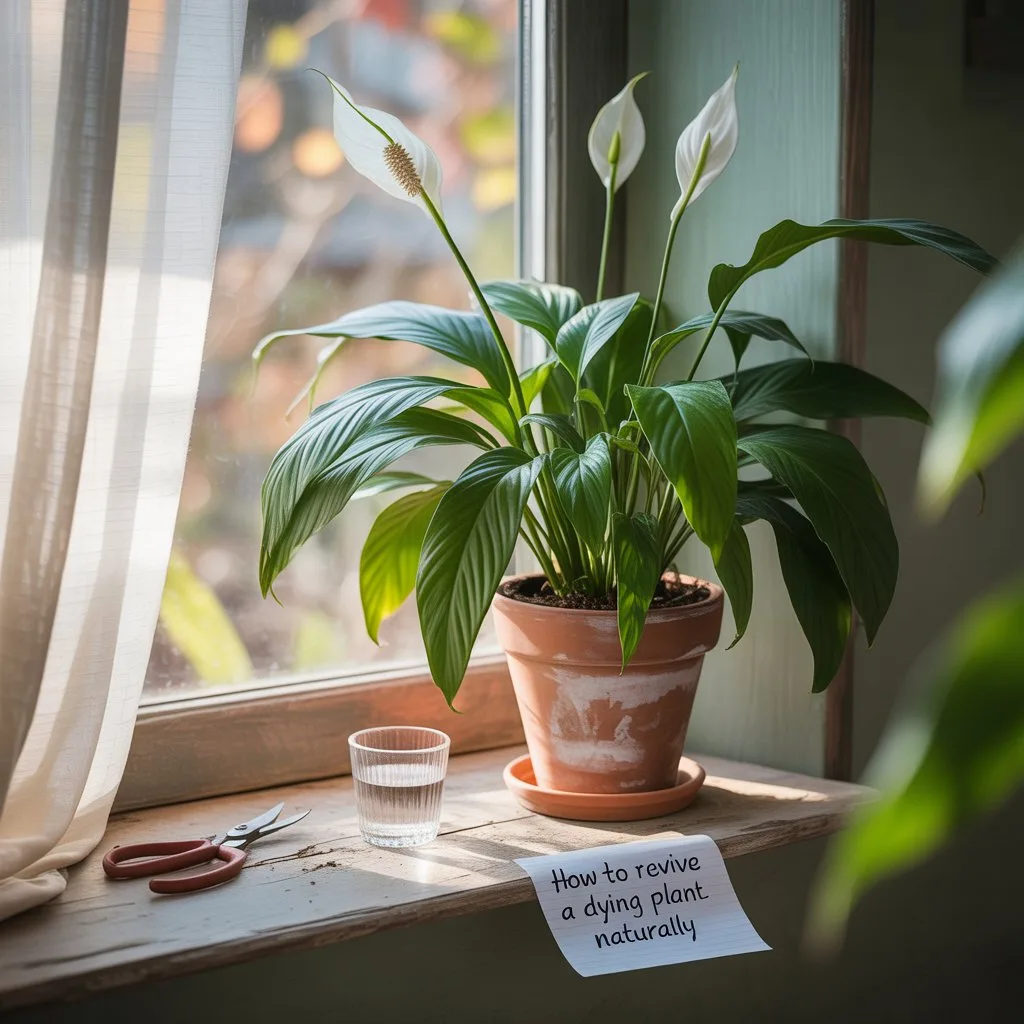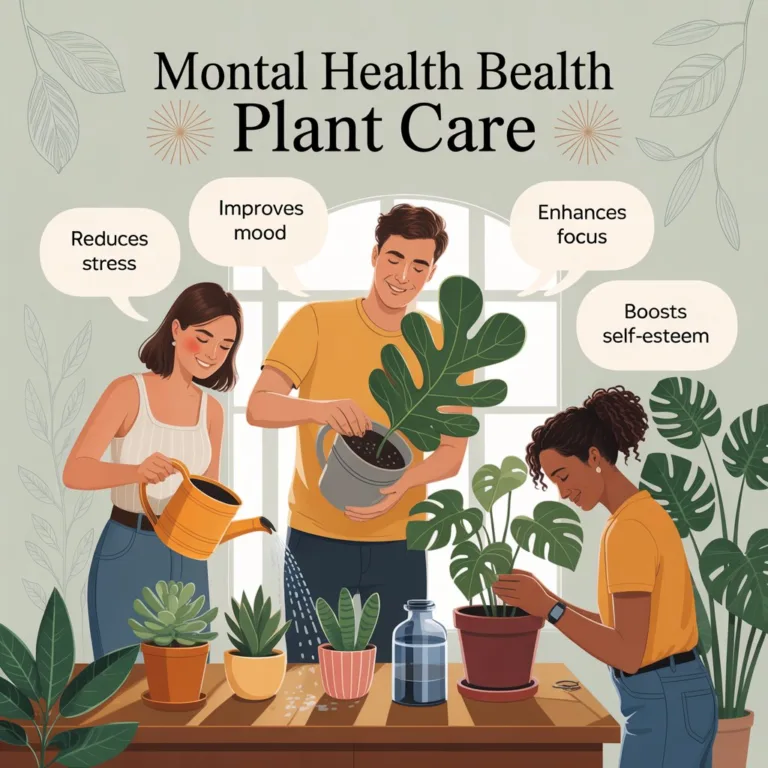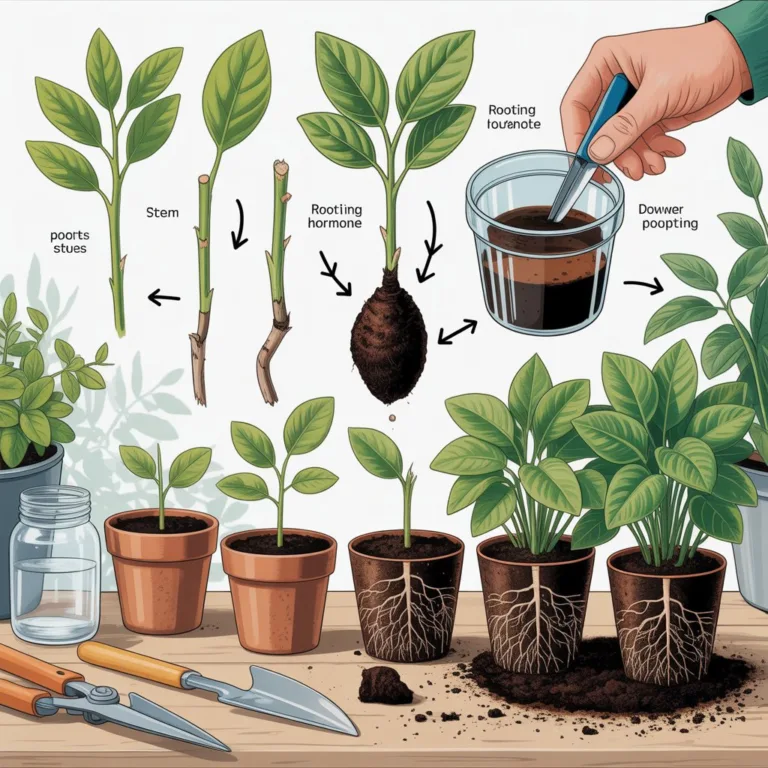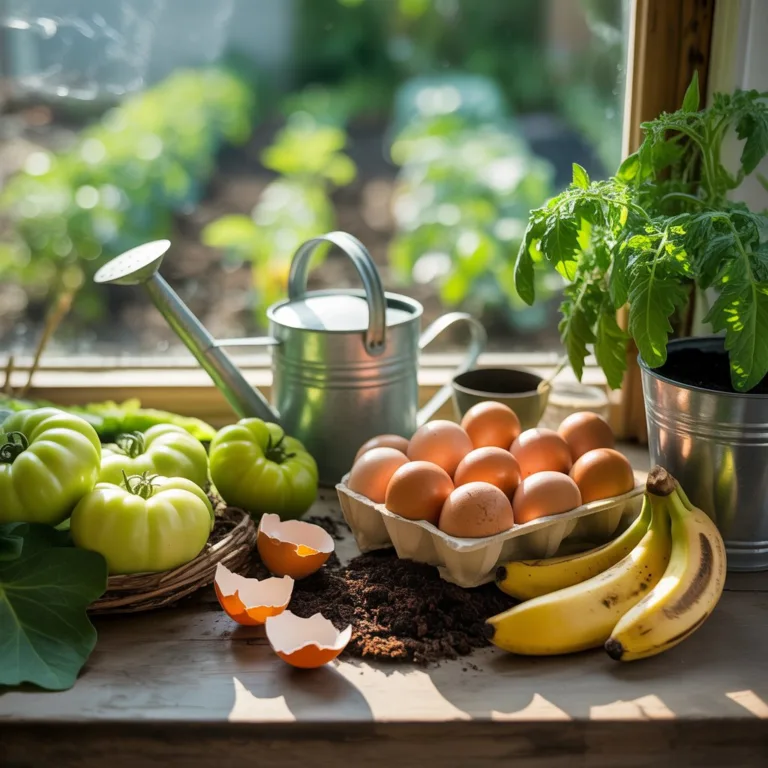Plants have an incredible ability to bounce back from the brink of death with the right care, patience, and understanding. Whether it’s a wilting fern, a drooping peace lily, or a dried-out succulent, learning how to revive a dying plant naturally is one of the most rewarding experiences for any plant lover. It’s not just about saving a bit of greenery—it’s about reconnecting with nature, understanding its signals, and taking responsibility for its care in an eco-friendly way.

Many people assume that once a plant starts to wilt or turn brown, it’s beyond saving. But in most cases, plants are simply crying out for attention and a change in their environment. By making a few natural adjustments—no chemicals, no harsh fertilizers—you can bring them back to life and help them thrive for years to come.
Let’s explore how to recognize distress signs, restore balance, and use natural remedies to revive your plants while creating a more sustainable indoor or outdoor environment.
Recognizing the Signs of a Dying Plant
Before you can revive a plant, you need to understand what’s wrong. Every plant communicates through its leaves, stems, and roots, showing signs that reveal the underlying issue.
- Wilting leaves: Usually a sign of inconsistent watering—either too much or too little.
- Yellowing leaves: May indicate nutrient deficiency, poor drainage, or lack of sunlight.
- Brown leaf tips: Often caused by low humidity, salt buildup from fertilizers, or harsh tap water.
- Dropping leaves: A reaction to sudden temperature changes, stress, or overwatering.
- Moldy soil: Indicates poor drainage or stagnant air circulation.
- Dry, brittle roots: A result of dehydration or prolonged exposure to heat.
Identifying these signs early helps you respond correctly. Once you know what your plant is trying to tell you, reviving it becomes much easier—and much more natural.
Assessing the Root of the Problem
Every plant’s health starts from the ground up. If the soil is unhealthy, the plant can’t absorb nutrients properly, no matter how much sunlight or water it gets.
Gently remove your plant from its pot and inspect the roots. Healthy roots should be firm and light in color. If they’re black, mushy, or smell unpleasant, root rot has likely set in—a common result of overwatering or poor drainage. Trim away the damaged roots with sterilized scissors, leaving only the healthy ones.
Then, repot the plant in fresh, organic soil with good drainage. A mix containing compost, coconut coir, and perlite works well for most species. Always ensure the pot has drainage holes to prevent future issues.
Reviving a dying plant naturally often starts with this one act of renewal—giving it a clean, nutrient-rich foundation to rebuild from.
Balancing Watering Habits Naturally
Watering is the most common mistake in plant care. Many people assume more water means more life, but overwatering is just as harmful as neglect. To revive a dying plant naturally, understanding its watering rhythm is crucial.
Insert your finger about an inch into the soil. If it feels dry, water the plant thoroughly until water drains from the bottom. If it’s still moist, wait a few days before checking again. For most houseplants, this simple method works better than any schedule.
Use room-temperature rainwater or filtered water whenever possible. Tap water can contain chlorine and salts that gradually damage the roots. Collecting rainwater is an eco-friendly way to hydrate your plants with soft, chemical-free moisture.
If you’ve overwatered, let the soil dry out completely before watering again. For underwatered plants, soak the pot in a bowl of water for 15–20 minutes so the roots can absorb moisture from the bottom up—a natural revival method that mimics how plants drink in nature.
Restoring Soil Health
Healthy soil is the lifeblood of any thriving plant. When a plant starts dying, it’s often because its soil has lost its balance of nutrients and microorganisms.
To rejuvenate tired soil naturally:
- Add compost: Homemade compost from food scraps, leaves, and coffee grounds enriches the soil with slow-releasing nutrients.
- Mix in worm castings: These natural fertilizers improve microbial activity and soil structure.
- Use crushed eggshells: A natural source of calcium that strengthens plant cells.
- Apply banana peel water: Rich in potassium, it supports root and flower health.
By restoring soil vitality, you’re creating the perfect ecosystem for your plant to recover and grow strong again—without any synthetic fertilizers or chemical additives.
Adjusting Light and Temperature Conditions
Plants thrive when they receive the right amount of light for their species. Too much direct sun can scorch leaves, while too little can cause yellowing and slow growth.
Observe your plant throughout the day. If it’s near a window with harsh afternoon sunlight, move it to a spot with filtered or indirect light. Conversely, if it’s struggling in a dark corner, place it closer to a bright window or supplement with a natural-spectrum grow light.
Temperature fluctuations are another silent killer. Keep plants away from air conditioners, heaters, and drafty windows. Most houseplants prefer consistent temperatures between 18–25°C (65–77°F).
Creating a stable, comfortable environment is one of the simplest ways to revive a dying plant naturally.
Using Natural Fertilizers to Feed Recovery
Chemical fertilizers can shock an already stressed plant. Instead, nourish it gently with natural, organic ingredients that rebuild strength slowly.
Here are a few effective, eco-friendly options:
- Compost tea: Soak compost in water for a few days, then use the liquid to water your plants. It’s packed with beneficial microorganisms.
- Seaweed extract: Adds trace minerals and stimulates root development.
- Molasses water: A small teaspoon in a liter of water boosts microbial life in the soil.
- Fish emulsion: A mild, natural fertilizer that encourages healthy growth without burning the roots.
Applying these organic fertilizers every few weeks can help your plant regain vigor naturally. Always use them sparingly—natural care is about balance, not excess.
Pruning to Encourage New Growth
Sometimes reviving a plant means letting go of the parts that can’t be saved. Dead or damaged leaves drain energy from the plant. Trim away brown or yellow leaves, as well as any wilted stems, using clean, sharp scissors.
This process redirects the plant’s energy toward producing new, healthy growth. After pruning, keep a close eye on new shoots—they’re a sign that the plant is responding well to your care.
For larger plants, consider cutting back stems just above a leaf node. This encourages branching and fuller growth once the plant recovers.
Regular, mindful pruning not only improves the plant’s appearance but also boosts air circulation, preventing mold and pest infestations.
Boosting Humidity Naturally
Many indoor plants originate from tropical regions and thrive in humid environments. If your plant has brown edges or crispy leaves, it may be suffering from dry air.
You can increase humidity in natural and sustainable ways:
- Group plants together: They release moisture through transpiration, creating a microclimate.
- Place a tray of water with pebbles near the plants: As the water evaporates, it adds humidity to the air.
- Use a room humidifier: A low-energy model can maintain a stable level of moisture.
- Mist leaves occasionally: Use filtered or rainwater to prevent mineral buildup.
These simple techniques mimic natural conditions and make your plants feel right at home again.
Protecting Against Pests Naturally
Even the healthiest plants can attract pests like aphids, spider mites, or fungus gnats. Instead of turning to chemical sprays, try these gentle, effective natural remedies:
- Neem oil spray: Mix a teaspoon of neem oil with water and a few drops of mild soap. It kills pests and prevents new infestations.
- Garlic or chili spray: Acts as a natural deterrent without harming the plant.
- Diatomaceous earth: Sprinkle a fine layer over the soil to eliminate crawling insects.
- Companion planting: In gardens, grow herbs like basil or mint nearby to repel pests naturally.
Keeping pest control natural ensures your plants, pets, and the environment remain safe.
Creating a Natural Plant Revival Routine
Once your plant begins recovering, establish a consistent routine to maintain its health. Observe it regularly, touch the soil, and notice new growth patterns. Small daily interactions help you understand your plant’s rhythm and prevent problems before they arise.
A natural care routine might include:
- Checking soil moisture every few days.
- Dusting leaves to allow better photosynthesis.
- Rotating pots for even light exposure.
- Refreshing the top layer of soil every few months.
- Composting dead leaves or trimmings to reuse nutrients.
The key to reviving plants naturally is mindfulness. The more attention you give, the more they thrive.
Encouraging Root Recovery Naturally
When a plant’s roots have been damaged, extra care is needed to rebuild their strength. Besides repotting into healthy soil, you can help root recovery with natural enhancers.
- Cinnamon powder: Acts as an antifungal agent to prevent rot in newly trimmed roots.
- Aloe vera gel: Stimulates root growth and provides natural hydration when mixed with water.
- Honey water: Serves as a mild antiseptic that encourages cell regeneration.
These natural remedies support healing without the harshness of synthetic root stimulants.
The Role of Patience and Observation
Reviving a dying plant naturally is not a quick process—it’s a journey. Some plants bounce back in a few weeks, while others may take months to fully recover. The important thing is to stay observant and patient.
Celebrate small signs of recovery, like new leaf buds or slight color improvement. Each one means your efforts are paying off. Avoid the urge to over-fertilize or overwater in hopes of speeding up recovery; natural healing takes time, and balance is key.
Every plant you bring back to life is a living reminder that care and persistence yield beautiful results.
Building a Sustainable Relationship with Your Plants
Learning how to revive a dying plant naturally teaches more than just gardening techniques—it cultivates mindfulness, patience, and a deeper appreciation for life. You start to notice how plants respond to your environment, and how your choices—like composting, collecting rainwater, or avoiding chemicals—impact their well-being.
Each revived plant becomes a small success story of sustainability. By caring for them naturally, you also care for the planet—reducing waste, conserving water, and supporting biodiversity right from your home.
Growing Forward
Reviving a dying plant naturally is not just an act of rescue; it’s a philosophy of nurturing life in harmony with the earth. The more you rely on organic practices, observation, and patience, the better your plants will reward you—with vibrant colors, steady growth, and renewed vitality.
If you have a struggling plant, don’t give up. Instead, listen to what it’s telling you, adjust gently, and allow nature to do the rest. Each new leaf that unfurls is a quiet triumph—a reminder that with time and care, almost anything can come back to life.
Keep exploring, experimenting, and learning. And the next time you see a wilted plant, you’ll know exactly what to do to help it thrive again—naturally.

Sofia Greenfield is a sustainable gardening expert and environmental educator who inspires families and urban gardeners to cultivate green spaces responsibly. She shares practical tips on growing vegetables, herbs, and flowers using eco-friendly and recycled materials, emphasizing the joy of gardening while protecting the planet.



